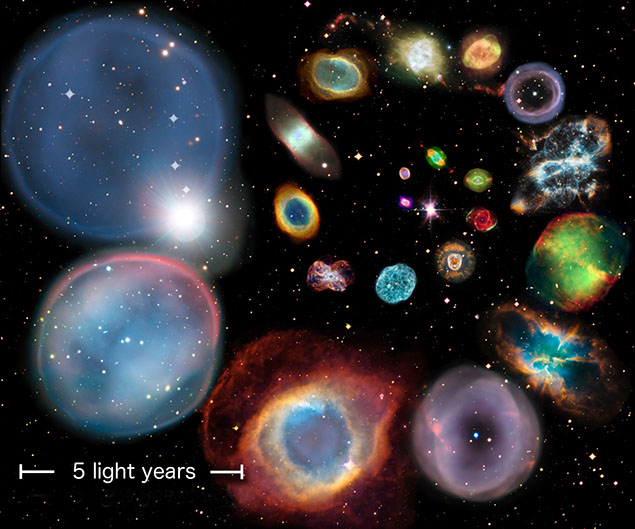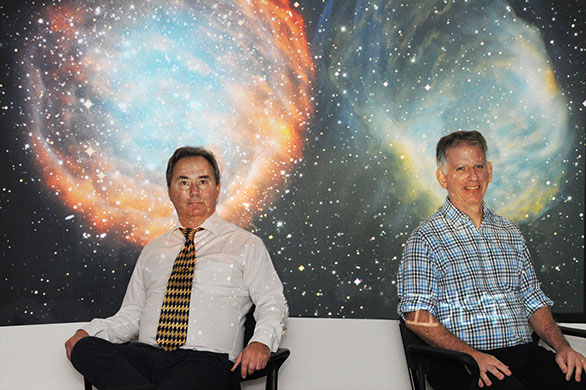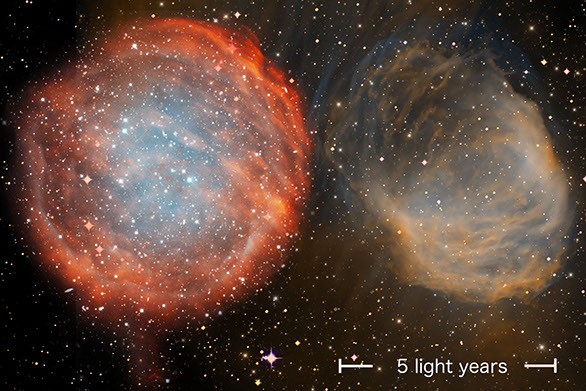Planetary nebulae potentially offer a wealth of information about dying stars, but astronomers have been unable to tap into that wealth fully because ascertaining their distance from Earth has been problematic.
Based on the culmination of 10 years of research work, a team of three astronomers in HKU’s Department of Physics – Dr David Frew, Professor Quentin Parker and Dr Ivan Bojicic – has come up with a more accurate technique to measure that distance. The implications of their new method, could enable a new era in our ability to study and understand the fascinating final stages of the lives of low- and mid-mass stars.
Planetary nebulae (or PNe) have long held the imagination with their distinct colours and complicated shapes, which range from soap bubbles, to butterflies. The name planetary is actually inaccurate, but came about because early astronomers such as William Herschel in the 1780s thought they resembled planets when in fact they are from dying stars. It wasn’t until the 1860s that the first spectroscope revealed they were not solid objects but gas. They are interesting to astronomers because they also offer a brief glimpse into the history of stars’ lives, but their scientific potential has been considerably reduced because it was so difficult to estimate their distances.
“Planetary nebulae are valuable tools for astronomers seeking a better understanding of how stars evolve and die, and of the nuclear processes acting in old stars and producing elements such as carbon and nitrogen,” said Dr Frew. “We want to know how and what elements are being recycled back into the Galaxy.
“Over the history of the Milky Way, the gas between the stars has become richer in heavy elements over time. If it hadn’t we humans wouldn’t be here – we’re mainly carbon, which wasn’t produced in the Big Bang. Material that once was in planetary nebulae is almost certainly in you and me.
“Measuring distances to Galactic planetary nebulae has been an intractable problem for many decades, because of the highly diverse nature of both the nebulae themselves and their central stars. However, knowing their distance is crucial to understanding their true nature and physical characteristics.”
The solution the team has come up with is a robust statistical distance indicator, using three sets of data. First, the size of the object in the sky taken from the latest high resolution surveys; second, an accurate measurement of how bright the object is in the red hydrogen-alpha emission line; and third, an estimate of the dimming toward the nebula caused by so-called interstellar-reddening. From these quantities, an intrinsic radius is calculated, which when combined with the angular size, yields the distance directly.
“The resulting surface brightness to radius relation has been calibrated using more than 300 planetary nebulae whose accurate distances have been determined via independent and reliable means – such as trigonometric parallax measurements of their central stars,” said Dr Frew. “It is not the technique that is new but the development of more accurate and reliable measurements means that this method is far more reliable than what has gone before.”

![]() Over the history of the Milky Way, the gas between the stars has become richer in heavy elements over time. If it hadn’t we humans wouldn’t be here – we’re mainly carbon, which wasn’t produced in the Big Bang. Material that once was in planetary nebulae is almost certainly in you and me.
Over the history of the Milky Way, the gas between the stars has become richer in heavy elements over time. If it hadn’t we humans wouldn’t be here – we’re mainly carbon, which wasn’t produced in the Big Bang. Material that once was in planetary nebulae is almost certainly in you and me. ![]()
Dr David Frew
Weeding out mimics
The new technique has also enabled the research team to weed out the ‘doppelgangers’, or mimics – that is, forms that resemble nebulae but are not – which in the past have contaminated PNe catalogues, by adding extraneous scatter to previous statistical distance scales.
It will also aid Dr Frew in his ongoing compilation of a far more accurate census of all the PNe in our Galaxy, work he began in 2006 at Macquarie University in Sydney.
“Currently the number of known PNe is wrong by a huge factor,” he said. “But when we have an accurate census we can work out the number of stars that are dying. If we know how many are dying we can see how much gas they are producing and what it is made of. It’s archaeological astronomy. We are looking at a cycle, a galactic ecosystem. We need to find out how far away these nebulae are, their age, the time they live for and the amount of material they are putting back into the Galaxy.”
So far, the three astronomers have used their new technique to create a catalogue of statistical distances for over 1,100 galactic PNe, the largest such compilation in the literature to date. Over the last 10 years, the team has more than doubled the number of known PNe in the Milky Way. For the past two centuries about 1,200 to 1,500 had been recorded – now 3,300 are known.
The new method to estimate more accurate distances between planetary nebulae and the Earth was developed by
Dr David Frew (right), Professor Quentin Parker (left) and Dr Ivan Bojičić.
The physical sizes of two of the largest planetary nebulae, presented at a common scale based on the authors’ new distances. Older distance scales underestimated the distances and hence sizes of these very old nebulae.
(Courtesy of NOAO/AURA/NSF, compiled by HKU Physics)

Distance Learning
A new technique to estimate distances between Earth and planetary nebulae accurately will give them a more meaningful place in astronomical research.


A collage showing 22 individual planetary nebulae all at various distances from Earth. They are artistically
arranged in approximate order of physical size. The scale bar represents five light years. Each nebula’s
size is calculated from the authors’ new distance scale, which is applicable to nebulae of all shapes, sizes
and brightnesses.
(Courtesy of ESA/Hubble & NASA, compiled by HKU Physics)
Next
Back


